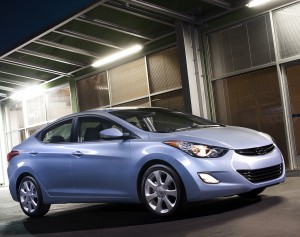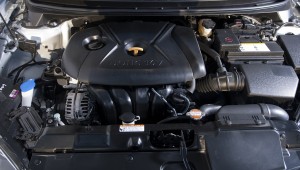Correction: Hyundai did not work with Microsoft to develop the Elantra’s infotainment system, according to a spokesman for the automaker.
When you’re traveling on business, the amount your company pays for mileage does not change based on the car you drive. Nope, whether you drive a high-mileage hatchback or a heavy-duty full-size pickup, the rate that your company pays for business travel is probably fixed, or, at best, tied to fuel prices.
The bottom line? If you drive a fuel miser, you’ll pocket more money from your mileage check than if you drive something with enough horses to power the city water treatment plant. And now that filling your tank costs enough to make you faint, it might be time to buy something that costs less than a night at a swanky hotel to fill.
Many recent Hyundais, such as this Elantra, seem to fit the bill. Hyundai has made a habit of introducing new cars rated at 40 mpg highway, including the midsize Sonata hybrid and of course, the subcompact Accent. The Elantra is also rated at 40 mpg. And that’s for a regular version with a six-speed automatic transmission. No strange continuously variable transmission. Not a special high-mileage version.
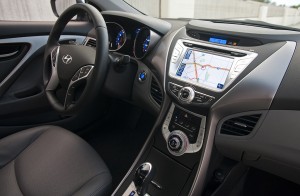
As is the norm for many cars these days, the Elantra has a well-styled interior. It's also finished well with no rough edges.
Besides Hyundai’s newfound efficiency, the other big change for the Korean automaker is styling. The first Hyundais to show up in the U.S. were odd, extremely basic or both, with curves in all the wrong places. They carried budget prices and looked like it.
Well, no more. The current Elantra sedan looks like a swoopier, seven-eighths scale Sonata, itself one of the most refreshing car designs of the decade.
Wow, Hyundai has come a long way since the days when its cars were always seen as the budget solution.
So now that Hyundais are stylish and fuel efficient, they’re expensive right? No, they’re not. Elantras start at $15,695 for the base GLS four-door. The top Limited model carries a base price of $19,980. That price includes 17-inch alloy wheels with 215/45 tires, power sunroof, six-speaker stereo, keyless entry, Bluetooth and leather seats plus six airbags. The Elantra Touring five-door hatchback starts at $16,745.
The premium package, including navigation, rear-view camera, premium audio, automatic headlights and keyless start adds $2,000. Throw in floor mats ($95) and an iPod cable for $35 for a total of $22,110.
As usual for the Koreans, a lot of car for slightly more than pocket change.
Powered by a 148-horsepower, 1.8-liter four cylinder, the Elantra is suitably peppy around town and has enough power to pass on two-lane highways. With the six-speed automatic, it’s rated at 29 city and 40 highway. We saw 33 in mostly freeway driving.
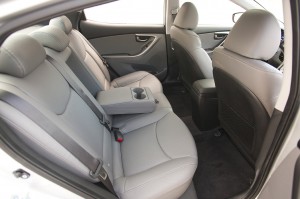
The Elantra has a comfortable rear seat, but taller folks won't have much headroom - the price of the swoopy roofline.
Around town, the Elantra is fun to drive, with sharp steering responses and no torque steer.
But problems arise on the freeway. There’s too much road noise emanating from the wheel wells. And, the wheels thwop uncomfortably over expansion joints at more than 70 mph. Also, the car refuses to track straight at higher speeds. It would seem that the relatively wide, low-profile tires don’t suit the car all that well.
Suspension tuning is about the only thing holding Hyundai/Kia back from world domination. The Genesis luxury sedan has a severe ride that borders on punishment and the Kia Sportage is also too stiff to be comfortable. Message to the Koreans: American roads are pockmarked with craters and U.S. drivers prefer a cushy freeway ride. Stiff suspension tuning is the norm in Europe and many Asian countries where roads are as smooth as billiard tables because of superior road-building techniques and bigger road budgets.
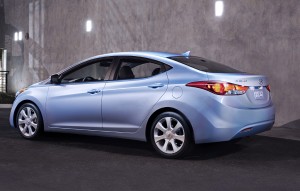
While strikingly beautiful, the Elantra's designers did not do quite as nice a job as they did on the Sonata at resolving all of its character lines at the back end.
Road noise also contributes to trouble with the voice-activated infotainment system. The system is reminiscent of the early Ford Sync systems, not surprising since it is basically the same setup, developed with the help of Nuance, which also handles voice recognition for Ford. Its understanding of commands is rather limited and the cacophony going on inside leads to the system failing to recognize many of the ones it is supposed to recognize.
The interior is comfortable, if a little short on headroom. There’s a price to pay for that sporty roofline. Taller drivers should consider buying the base GLS rather than the Limited which comes with a standard sunroof. The front seats are comfortable, but they seem to be tilted forward. It adjusts for height, but seat bottom does not angle. Also, it seems strange to have no power adjustments on this car, considering all the other goodies. Oh well, to keep the price down, corners have to be cut somewhere.
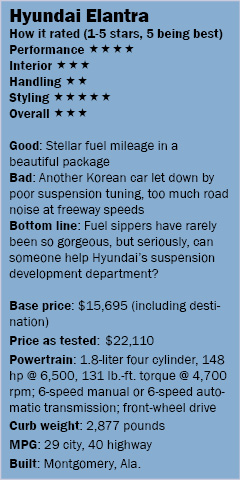 Where they didn’t cut corners is in fit and finish. There isn’t a rough edge anywhere. There are cubby holes for iPods, cellphones and other commuting detritus as well as two power outlets.
Where they didn’t cut corners is in fit and finish. There isn’t a rough edge anywhere. There are cubby holes for iPods, cellphones and other commuting detritus as well as two power outlets.
There were also no corners cut in the design department. The most distinctive feature is a character line that runs from the just behind the front wheels all the way to the back where they intregrate with the taillights. Although not quite as artfully done as on the Sonata, it is still quite striking. The windshield is severely raked – so much so that a rather odd, long driver’s side wiper and tiny passenger side wiper are required to clean the glass.
In keeping with current standards, the interior is also striking, with plenty of interesting shapes and designs.
While the Elantra is a sedan, it has a hatchback-ish look, with a steeply raked rear window. The trunk opening is narrow, but it’s still rather spacious. A 60/40 split rear seat expands cargo space. The Elantra hatchback is more traditional, with an upright rear window.
The Elantra presents a great way to turn company mileage into profit-sharing checks. Now, if its maker could get a handle on the black art of suspension tuning, it could sell truckloads of these things.

